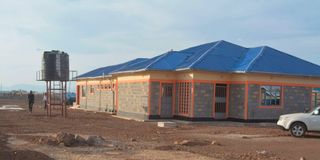First ever mortuary in Turkana West a relief for residents and refugees

A newly constructed mortuary at Kakuma Sub-county Hospital in Turkana West.
What you need to know:
- A mortuary, maternity wing, male ward, and a new laboratory have been constructed at Kakuma Sub-County Hospital at a cost of Sh31 million.
- At Kalobeyei Centre, Sh14 million has been spent on construction of a much-needed maternity wing, a female ward and staff quarters.
Residents of Turkana West Sub-county and refugees at Kakuma Refugee Camp are breathing a sigh of relief following the construction of the first ever mortuary as well as more wards and maternity wings at two health facilities.
These were built as part of the Development Response to Displacement Impacts Project (KDRDIP), a national government initiative supported by the World Bank to improve the lives of the refugee-hosting communities.
The initiative has seen a mortuary, maternity wing, male ward, and a new laboratory constructed at Kakuma Sub-County Hospital at a cost of Sh31 million. At Kalobeyei Centre, Sh14 million has been spent on construction of a much-needed maternity wing, a female ward and staff quarters. The chairman of Kakuma Sub-County Hospital Project Management Committee, Mr Patrick Tioko, said it has for years been an expensive encounter whenever relatives, friends and neighbours die.
“When one dies in Kakuma, it costs Sh10,000 to transport the body to the only mortuary in Lodwar located 120 kilometres away, pay for the number of days the body will stay there for preservation and spend another Sh10,000 to bring the body back.” He said poor families bury their loved ones without confirmation of the cause of death or without all relatives being present. Others, he said, always turn to politicians for help — an option that has never been reliable. Mr Paul Jalinga, a resident of Kakuma, recalled that when he lost his brother at Kakuma Mission Hospital on August 5, 2017, he was confronted with a big decision to make: either take the body for burial immediately or fork out more money to transport it to Lodwar for preservation. “Though I wanted more days to mourn my brother, plan his funeral and prepare a decent send-off, we were unable to raise enough money to transport the body to Lodwar and as a family we agreed to bury him before sunset,” Mr Jalinga said of the norm for many families in the sub-county with a population of 450,000 people, including 210,000 refugees.
The KDRDIP team leader Wilfred Omari, who had accompanied World Bank Team Leader Matthew Stephens, World Bank Sector Leader for Sustainable Development Ragini Dalal and other officials during a three-day visit in Turkana West to take stock of progress made by the government initiative, said they had done tremendous work in improving health services.
“For the first time, we have been able to put up a mortuary at Kakuma Sub-County Hospital, a maternity wing, a laboratory and a male ward as well as fence the facility as requested by the locals. This will help to provide services closer to the people instead of travelling to Lodwar,” Mr Omari said.
He said the mortuary will be operational from next month after it has been fully equipped and connected to a reliable power and water supply; and that it will accommodate 50-100 bodies.
“DRDIP has already signed a memorandum of understanding with Turkana County government on operations and maintenance of the facility to ensure it sufficiently serves the people of Turkana West sub-county and those nearby,” Mr Omari said.
For Ms Antoninah Ekal, a laboratory and maternity wings will save lives by boosting diagnostic and maternal healthcare services respectively. She said many locals were opting for over-the-counter treatment, a practice that has been worsening illnesses. “Maternity wards will encourage more women to give birth in hospital than at home where births are associated with a higher risk of infant death,” Ms Ekal said.
A staff quarters at Kalobeyei Centre, she said, will ensure that health workers stay at the facility to even serve residents at night.





